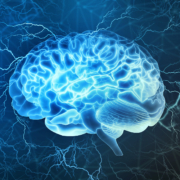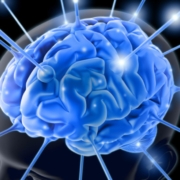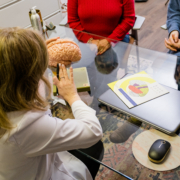How Does Exercise Improve Brain Function?
Having a clearer head after a workout isn’t a fluke. For thousands of years—stretching back to the time of philosophers like Plato—people have recognized that exercising helps your mind. In the modern world, researchers have tried to understand how this happens. What is it about exercise exactly that supports learning and thinking?
“Exercise is what we call pleiotropic,” said J. Carson Smith, PhD. This means that exercise has many effects on the body. Dr. Smith is a professor in the Department of Kinesiology at the University of Maryland at College Park who has been studying the intersection of exercise and brain function for 25 years.
“Exercise impacts every system in the body simultaneously, so it’s not easy to isolate exactly one particular thing it causes,” he said. “There are probably dozens of things that happen, that interact, that end up showing exercise to be beneficial.”
Today, experts confidently identify several ways that exercise improves brain function.
These positive effects on the brain—brought about by exercise—are particularly beneficial for adults at risk of neurodegenerative diseases. But they are also helpful for everyone. Clearer thinking, better memory and stronger executive functioning are as important to a 10th grader as they are to a new mom, business executive or grandparent.
Your Blood Flow
First, let’s look at how our blood flows through the body. Long-term exercise, especially cardiovascular exercise, increases blood flow throughout the body, including to the brain. This means a person who exercises regularly is getting more oxygen to their brain, which keeps the cells fueled and can help maintain cell health.
This increased blood flow “keeps your brain stocked with the things it needs in order to operate,” explained Joyce Gomes-Osman, PhD, PT, voluntary assistant professor of neurology at the University of Miami and founder of Physical Therapy for Mental Sharpness, where she provides personalized, brain science-informed physical therapy to older adults.
In addition, increased blood flow moves out brain waste and helps decrease inflammation in the brain. Too much inflammation in the brain can lead to neurodegenerative diseases such as multiple sclerosis, Parkinson’s disease or dementia like Alzheimer’s disease. Reducing inflammation—like by exercising—can keep your brain healthy and functional.
However, higher blood flow on its own isn’t always a positive sign. “As people get older and they start to decline cognitively, they get increased blood flow just because their brain is trying to compensate for their inability to do things,” Dr. Smith said. “As people start to have signs of cognitive decline or dementia, they actually have hyperperfusion (increased blood flow) of their brain.”
In these cases, exercise is still helpful. In one study, Dr. Smith and his colleagues found that 12 weeks of exercise training normalized the excess blood flow in people with a mild cognitive impairment.
Your Hippocampus
Now let’s look at the hippocampus. This is one of the most commonly studied parts of the brain, especially when it comes to researching exercise and the brain. The hippocampus is tasked with creating new memories, converting them to long-term memories (which are sent to and stored in other parts of the brain), and processing the space around us.
The hippocampus is the only part of the brain that can produce new brain cells. It is uniquely vulnerable to age-related atrophy and neurodegenerative conditions, but it can also respond positively to exercise.
Numerous studies have found that exercise or cardiovascular fitness help create processes that protect the hippocampus.
“In animal studies, exercise stimulates growth of new neurons (brain cells) in the hippocampus,” Dr. Smith said. “In humans, it’s not as clear that that happens, but there is some suggestion that it could happen. Most likely what exercise is doing is helping to maintain the hippocampus as we age and not allowing it to decline as much, which helps to preserve memory function.”
Exercise sparks the growth of new “dendrites,” which are like branches that stretch out from nerve cells. Dendrites receive messages from neighboring brain cells. Exercise also increases the levels of neurotransmitters, which are the chemicals that serve as messengers for the nerve cells, Dr. Gomes-Osman said.
Both of these changes happen in the hippocampus and throughout the rest of the brain. And both support neuroplasticity, or the brain’s ability to adapt.
According to Dr. Smith, older adults at risk of Alzheimer’s disease who are physically active over the course of 18 months show greater preservation of the hippocampus than those who are less active. Even single sessions of exercise, he said, can improve memory and executive function. MRIs taken after exercise sessions revealed brain activation patterns that align with better cognition—in the hippocampus and elsewhere.
Because the hippocampus is connected to many other parts of the brain, improvements in the hippocampus are promising for overall brain health.
In a 2023 research paper, Dr. Smith and his students showed that hippocampus connectivity to other brain regions mediates the association between cardiorespiratory fitness and cognitive function. In other words, good connections between the hippocampus and other parts of the brain help cardiorespiratory fitness improve or maintain strong brain function.
Your Brain’s Network
Your brain cells and the pathways that connect them are called the “connectome.” Changes in the connectome tend to happen before you recognize any cognitive changes. Because the brain works as a system—not as individual parts doing their jobs by themselves—researchers are dedicating more attention to understanding how exercise affects the brain as a whole.
“There’s much more of a focus these days on not just how exercise affects the single brain area, but looking at the brain networks that are coordinating to promote good cognitive function,” Dr. Smith said.
These brain networks encompass multiple parts of the brain, but they are dedicated to specific tasks. For example, the “salience network” detects features of your environment that could be important for your survival. The “frontoparietal network” is involved with what you are actively paying attention to and doing.
To do their jobs well, these networks need to maintain some separation—or segregation—from each other. But age or conditions like dementia can cause that segregation to deteriorate.
“As the person becomes older and they begin to lose their cognitive function … the brain will compensate for that by recruiting other brain networks to try to help,” Dr. Smith said. “That is OK for a little while, because it helps the person remember where they parked their car, but over time the blending of those brain networks disrupts the specialization of function that they have.”
The good news is that just one session of exercise can help separate those networks again. This “resegregation” promotes structural efficiency within the brain, which is related to better executive function. Executive function relates to the mental skills we need to do everyday tasks. These are things like brainstorming, making plans and adapting to new situations.
Exercise may also strengthen connections within the individual brain networks. Together, this segregation and within-network connection allow each network to do its job without interference from the other networks.
Your Brain on Exercise
These positive effects on the brain—brought about by exercise—are particularly beneficial for adults at risk of neurodegenerative diseases. But they are also helpful for everyone. Clearer thinking, better memory and stronger executive functioning are as important to a 10th grader as they are to a new mom, business executive or grandparent.
“It’s never too late, it seems,” said Cay Anderson-Hanley, PhD, a professor of psychology and director of Neuroscience at Union College in Schenectady, New York. “We’ve seen some publications that look at young adults or youth that engage in team sports, so they’re very active … and then, even if they have a period where they become midlife and not so active, that early exercise experience somehow gives a good foundation for the brain that benefits it later in life.” When it comes to brain health, Dr. Anderson-Hanley said physical exercise appears to be an important part of staying sharp. Or, as Dr. Smith put it: “Exercise is medicine for your brain.”









